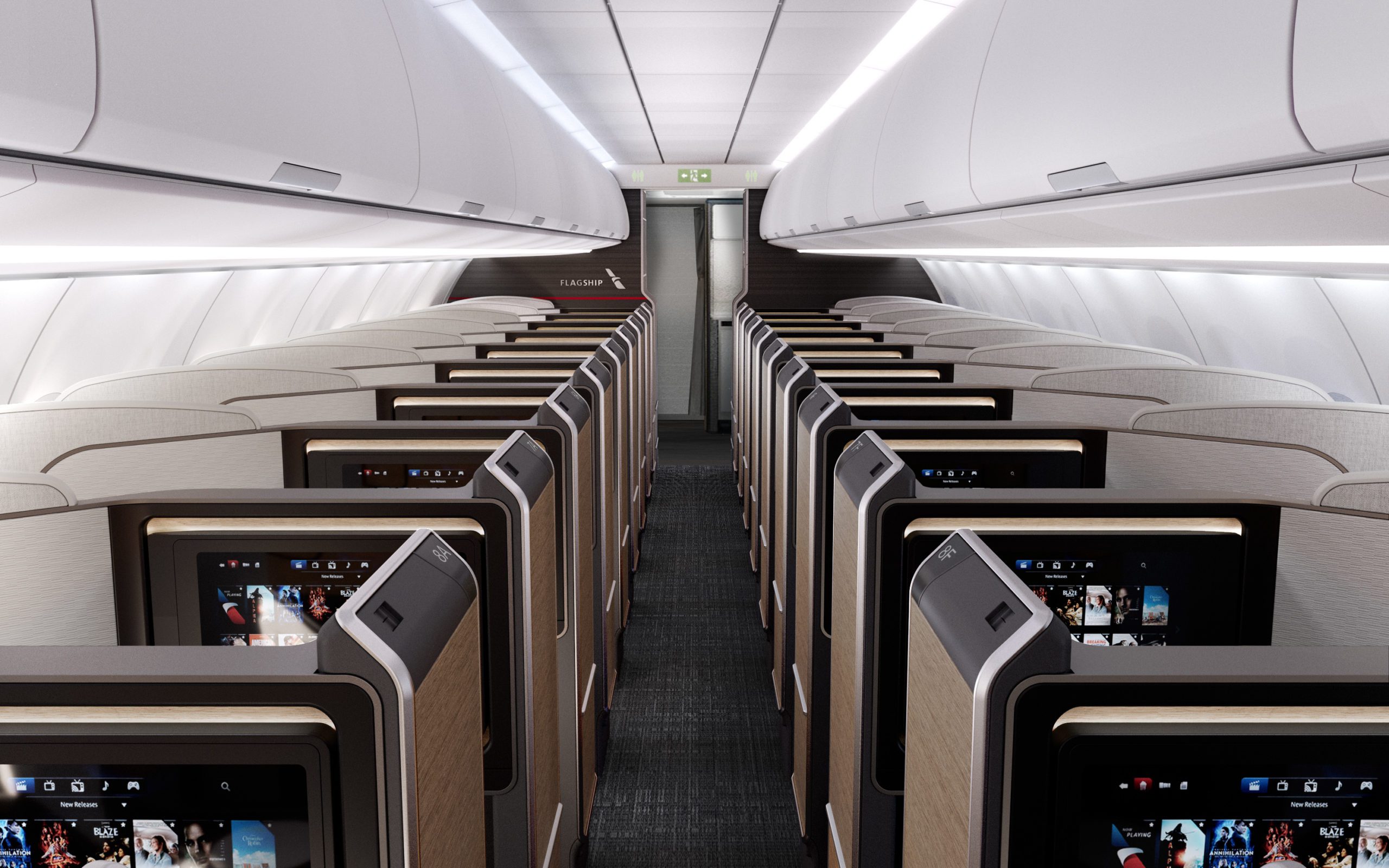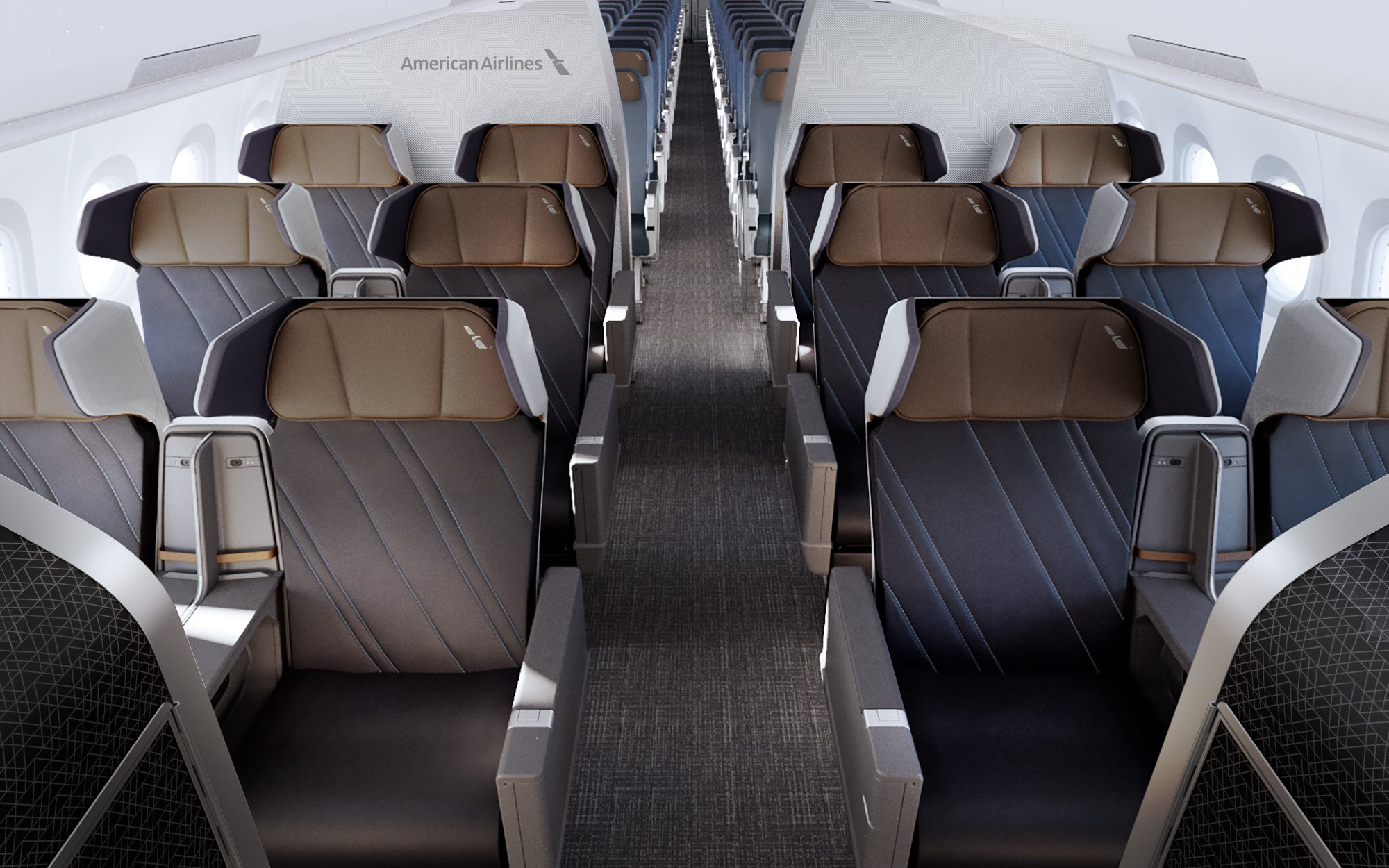American Airlines expects to begin taking delivery of new extended range narrowbody planes – the Airbus A321XLR – starting in the first quarter of 2024.
At an internal meeting, a recording of which was reviewed by View From The Wing, executives at the airline discussed how they plan to deploy the plane.
Vice President of Network Planning Brian Znotins shared that they’re still “working with Airbus on the range” of these aircraft, and so they aren’t actually sure what routes it will be able to service. However,
- They will be based primarily at New York JFK and Philadelphia. This makes sense because they can fly short transatlantic operations, and these hubs offer the shortest distances across the Pond, able to reach more cities. In addition, the plane is expected to deploy on some premium cross country routes to and from New York.
- >They will also show up in Charlotte, Chicago O’Hare, and Miami operating thin routes to major European destinations mostly, I would imagine, though basing some at Miami could mean northern South America.
In Charlotte the A321XLR will be additive allowing for some new routes without the demand to sustain a widebody aircraft, and it will also swap with widebodies seasonally – widebodies in the summer, the narrowbody over the winter to Europe when demand drops. Charlotte is a stretch to reach some European destinations with the XLR so it won’t open as many routes as it will for its northern hub cousins.
The Airbus A321XLR will be good for Charlotte because its lower costs, and ability to fill planes with fewer passengers, means that Charlotte can support more international flying. There are only so many European destinations from Charlotte that will support a Boeing 777, and there are more that American Airlines can fly to with the smaller XLR.
Massimo Mancini, Vice President of Commercial Planning and Analysis, noted that the XLRs will be used on premium cross country flights. American hasn’t spoken to this specifically, and indeed I still wouldn’t be surprised to see some widebody aircraft used on premium cross country flights as well, as the A321T is phased out.
Over the summer I wrote to expect American to use these Airbus A321XLRs on premium cross country routes allowing them to reconfigure their existing premium A321T fleet to offer standard domestic cabins. That means no more Flagship First Class, a better business class (no longer 2 x 2), and a less premium coach product. That’s exactly what they are doing.
American is putting new business class and premium economy seats in these planes. Business class will be suites with doors, with direct aisle access, just one seat on each side of the aisle. That’s going to be a highly competitive hard product whether it’s flying internationally or on premium domestic routes.

Credit: American Airlines

Credit: American Airlines
While I love the spaciousness of a widebody aircraft, I’m really looking forward to the premium experience on these planes. And I’m looking forward to a premium experience on routes that didn’t previously support one. I’m also grateful for the expected range of the XLR, so that it can be better-used on long routes than comparable Boeing aircraft which have a narrower fuselage and therefore end up having a less desirable passenger experience.


Curious to hear Gary and other commentators on new or returning seasonal or year round long-haul service out of CLT using the A321XLR. Ignore existing service that may be downgauged seasonaly
My prediction list:
– AMS
– BCN
– ZRH
– MXP
– HNL/OGG/LIH?
Unlikely but bold and innovative:
– CMN
– HEL
– BOG
I can see FCO, CDG, DUB going year-round
This aircraft should be a big help to AA’s not-super-profitable PHL hub. I assume they will deploy it to secondary European markets that can’t support widebody transatlantic flights and collect those passengers at PHL instead of at their partners/competitors European hubs. This will mean more European flights from PHL, and more domestic seats to fill the int’l connections. They can also use the aircraft on marginal PHL widebody routes in the off-season..
As much as I want AMS from CLT for selfishly personal reasons, I don’t see this happening as it would be a destination flight. There is no real One World connectivity from AMS. Destinations such as any cities within the OW network (i.e. anything in the UK, Spain, Finland) would make the most sense from CLT.
I have flown the TAP and Air Lingus trans-Atlantic A321 product in premium economy and I have been impressed. So this will be a good addition.
I expect Mad to be included on that list along with Lis @ Por
It would be great if this could open up some routes to Brazil from MIA other than just GIG and GRU.
Everyone gets excited about the A321XLR but it is far from clear how well its economics will compare to widebodies.
PHL and CLT connecting traffic is very much in the captive area for other hubs including BOS, JFK, EWR, IAD and ATL – all of which have far higher local traffic and also more connecting traffic to support these type of flights.
Maybe the A321XLR will really allow AA to competitively and profitably serve flights that widebody aircraft serve from other hubs but AA has, by far, the worst track record of getting an acceptable return on investment for its fleet spending and in making fleet decisions that translate into competitive advantages.
and, of course, the statement that Airbus and AA are working to define the range of the XLR means that it is far from certain that real world performance will be anywhere near as great as some people think – esp. given that the XLR will cruise considerably slower than any widebody.
The 1X1 configuration in business doesn’t cater to couples at all. I would like to see a layout like Jetblue has with Mint: alternating rows of 2s and 1s:
2X2
1X1
etc.
As someone based in CLT, I just want to see international routes in business that are reasonably bookable with miles. For a while now everything has been 200k+ miles. It’s always been easier to fly cheaply to JFK and then use miles from there. When paying out of pocket, you can even fly FC out of JFK at cheaper rates than business class out of CLT. And that’s including LH/LX/AF FC compared to shitty AA business class out of CLT. I don’t understand who pays these transatlantic rates out of CLT, whether by miles or cash.
It seems like none of these options actually leverage the range of the A321XLR over the LR (which also happens to be already flying, unlike the XLR), so I wonder why would AA be paying and waiting at minimum another year for the XLR? The only thing I can come up with is that Airbus gave AA a really sweet deal to specifically get the XLR on their roster for marketing purposes?
Call me crazy but i actually prefer narrowbodies. the crowds on widebodies are a bit much for me, at least in coach. Id rather fly coach on an A321 to hawaii than on a 787, for example. the seats on the 787s/777s are generally not as wide as on the A321s.
Tim Dunn, I sense that AA has a planning group that applies network theory to a number of variables to identify hub locations, aircraft types, schedules, etc. in a rational and scientific manner. Then, AA’s leadership comes in (without a real understanding) and changes this and that, which makes the network less efficient and (to your point) reduces its ROI.
Does AA want to primarily focus on a domestic network that is fed by its partners? Or, does it want to truly play in the trans-Atlantic game? I sense AA leadership itself doesn’t have clarity on the matter.
I wish they’d fly to BXH. Someone needs to.
TAP’s A321neo changed my perspective of single aisle vs. twin-aisle across the pond. Last month we took one from LIS-EWR (Economy Comfort). Between the spacious feeling of the Airspace interior, and the surprisingly quiet interior (row 9d, e, f) it felt as good as any widebody.
I’ve always loved the convenience of nonstops that comes with the overpowered toy that is the 757. pm-CO and AA frequently used these to cross the pond from EWR/JFK respectively. But, the experience lagged vs. widebodies. No longer the case with the neo.
Gary, you can map the range of the XLR quite easily. http://www.gcmap.com/mapui?R=4700nm%40clt4700nm%40mia&MS=wls&DU=mi
All of South America is reachable from Miami with this bird, northern SA isn’t far at all. And most of Europe that matters is available too. And from Charlotte, basically any route in SA or Europe is within range as well.
Tim Dunn wrote: “Everyone gets excited about the A321XLR but it is far from clear how well its economics will compare to widebodies.”
——–
Prove it. I’m pretty sure Airbus, United and American have a reasonably good idea of the economics of the aircraft or else they wouldn’t be investing in it. Just because the world’s only PERFECT airline hasn’t Ordered the plane doesn’t mean a thing.
======
Tim wrote: “PHL and CLT connecting traffic is very much in the captive area for other hubs including BOS, JFK, EWR, IAD and ATL – all of which have far higher local traffic and also more connecting traffic to support these type of flights.”
——
Proof? How much is “far” more? You keep coming to these conclusions and rarely offer a shred of evidence to back them up.
======
Tim wrote:” Maybe the A321XLR will really allow AA to competitively and profitably serve flights that widebody aircraft serve from other hubs but AA has, by far, the worst track record of getting an acceptable return on investment for its fleet spending and in making fleet decisions that translate into competitive advantages.
—-
By far????? What constitutes “by far”?
Proof????
==========
Tim continues: “…and, of course, the statement that Airbus and AA are working to define the range of the XLR means that it is far from certain that real world performance will be anywhere near as great as some people think – esp. given that the XLR will cruise considerably slower than any widebody.
—–
FAR from certain?????? Again, the fact that there’s work in progress is evidence (not proof) that the parties know what they’re shooting for.
Tim, Why do you want American and United to be liquidated?????? Why the vendetta?????